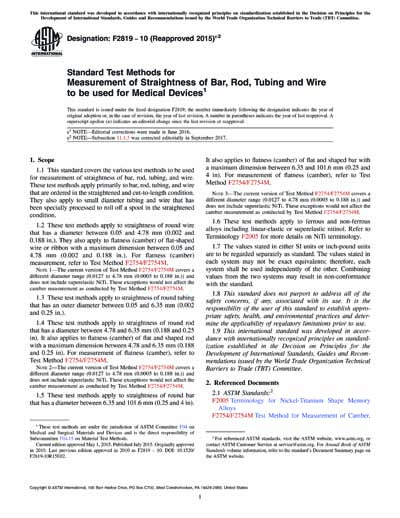Most recent
ASTM F2819-10(2015)e2
Standard Test Methods for Measurement of Straightness of Bar, Rod, Tubing and Wire to be used for Medical Devices
1.1 This standard covers the various test methods to be used for measurement of straightness of bar, rod, tubing, and wire. These test methods apply primarily to bar, rod, tubing, and wire that are ordered in the straightened and cut-to-length condition. They also apply to small diameter tubing and wire that has been specially processed to roll off a spool in the straightened condition.
1.2 These test methods apply to straightness of round wire that has a diameter between 0.05 and 4.78 mm (0.002 and 0.188 in.). They also apply to flatness (camber) of flat-shaped wire or ribbon with a maximum dimension between 0.05 and 4.78 mm (0.002 and 0.188 in.). For flatness (camber) measurement, refer to Test Method F2754/F2754M.
Note 1: The current version of Test Method F2754/F2754M covers a different diameter range (0.0127 to 4.78 mm (0.0005 to 0.188 in.)) and does not include superelastic NiTi. These exceptions would not affect the camber measurement as conducted by Test Method F2754/F2754M.
1.3 These test methods apply to straightness of round tubing that has an outer diameter between 0.05 and 6.35 mm (0.002 and 0.25 in.).
1.4 These test methods apply to straightness of round rod that has a diameter between 4.78 and 6.35 mm (0.188 and 0.25 in). It also applies to flatness (camber) of flat and shaped rod with a maximum dimension between 4.78 and 6.35 mm (0.188 and 0.25 in). For measurement of flatness (camber), refer to Test Method F2754/F2754M.
Note 2: The current version of Test Method F2754/F2754M covers a different diameter range (0.0127 to 4.78 mm (0.0005 to 0.188 in.)) and does not include superelastic NiTi. These exceptions would not affect the camber measurement as conducted by Test Method F2754/F2754M.
1.5 These test methods apply to straightness of round bar that has a diameter between 6.35 and 101.6 mm (0.25 and 4 in). It also applies to flatness (camber) of flat and shaped bar with a maximum dimension between 6.35 and 101.6 mm (0.25 and 4 in). For measurement of flatness (camber), refer to Test Method F2754/F2754M.
Note 3: The current version of Test Method F2754/F2754M covers a different diameter range (0.0127 to 4.78 mm (0.0005 to 0.188 in.)) and does not include superelastic NiTi. These exceptions would not affect the camber measurement as conducted by Test Method F2754/F2754M.
1.6 These test methods apply to ferrous and non-ferrous alloys including linear-elastic or superelastic nitinol. Refer to Terminology F2005 for more details on NiTi terminology.
1.7 The values stated in either SI units or inch-pound units are to be regarded separately as standard. The values stated in each system may not be exact equivalents; therefore, each system shall be used independently of the other. Combining values from the two systems may result in non-conformance with the standard.
1.8 This standard does not purport to address all of the safety concerns, if any, associated with its use. It is the responsibility of the user of this standard to establish appropriate safety, health, and environmental practices and determine the applicability of regulatory limitations prior to use.
1.9 This international standard was developed in accordance with internationally recognized principles on standardization established in the Decision on Principles for the Development of International Standards, Guides and Recommendations issued by the World Trade Organization Technical Barriers to Trade (TBT) Committee.
Content Provider
ASTM International [astm]






